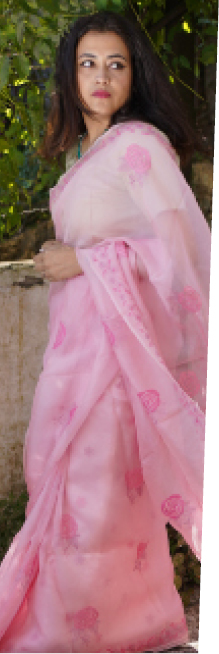The word quiet elegance sits perfectly on the gracious frame of Veena Singh, born into the Padrauna noble family. She is married to J.P. Singh, a politician from the Congress party, belonging to the Ram Nagar family of Benaras.
A true symbol of Avadh’s statuesque life, Veena has spent her life empowering women and keeping the tradition of Lakhnavi embroidery alive. The founder of her self-funded NGO Women Welfare Foundation, she has over the years taught the craft of shadow work to over thousand young girls who are now self-employed and working within the comfort of their homes. “My intention is two-pronged: to keep the craft rich and rooted and also help these women stand on their feet.”



Veena was born in Padrauna, a small town in Kushinagar, Uttar Pradesh, its ancient name being Pava. “It is the region where Buddha took his last meal and also where Lord Rama spent a few days of his life before taking banwas at Ramkola nearby where he lived in a hut with Sita. It is also the seat of the Malla Kshatriyas and had three viceroys visit the state.” For her, “It is our home town. Where my family ran factories, lived their lives and our ancestors ruled.”
Veena came to study at Loreto Convent in Lucknow, got married and made Qaisar Bagh her home. It was soon after that she got into the revival of Chikankari for which she has not only won awards but also enjoyed reviving, restoring and creating a stunning collection of saris. She shares, “Chikankari is the craft of rendering shadow work on gossamer textiles in a tone-on-tone palette. It is inspired by the most everyday sources of life. Like the kangan (bangle), ghas patti (grass), chana patti (tea leaves), keel (nose pin) and bakhiya (shadow). However, how each of these motifs is interpreted by hand is what makes it so spectacular.”
Yet, “Lucknow in the 1980s was becoming a place for cheap embroidery. No one had the patience to render these delicate stitches onto thin handmade mulmuls and chiffons. They were busy selling thick embroidery on mill cotton to the world.” The sad part was, “In the villages, several women were waiting and ready to learn to be fruitfully employed.”
And hence she brought alive her foundation through which, “I send teachers and supervisors to the villages that surround Lucknow to train women in the craft at home. They work with a room full of women, teaching them these hand embroideries from scratch. I have even stormed gender biases by teaching them mukaish and Zardozi that were traditionally practised by men.”
Once trained, they take part in a yearly competition by the Laghu Udyog that certifies them post which they are free to work wherever they want. “Meanwhile I buy straight off whatever they have created for me,” adds Veena.
Working with the finest hand weaved maheshwaris, chanderis and georgettes, besides the traditional mulmul, she creates saris in pleasant shades of pinks, blues and greys, “The kaarigars of the past were influenced by what they called ‘British colours’, though white on white is the most lasting icon of this craft. They embroidered the most stunning shararas and ghararas for the royal begums of Avadh. Women of stunning complexion did total justice to this craft that reached its zenith under Wajid Ali Shah. The inclusion of the auspicious fish motif came into the fore during his reign.” Veena believes, “Shadow work is the pride of Lucknow and each of us must possess at least one piece of this craft as an ode to the kaarigari of Avadh.”







